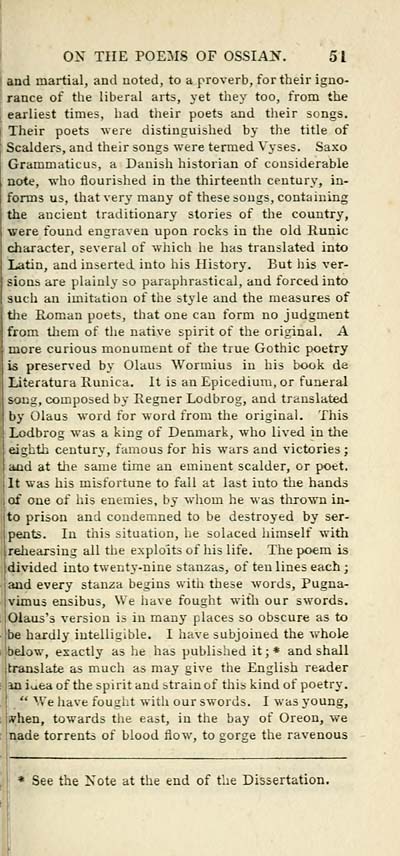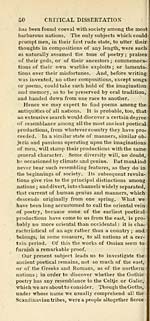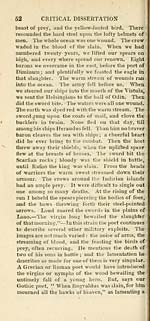Ossian Collection > Poems of Ossian
(99)
Download files
Complete book:
Individual page:
Thumbnail gallery: Grid view | List view

ON THE POEMS OF OSSIAN. 51
and martial, and noted, to a proverb, for their igno-
rance of the liberal arts, yet they too, from the
earliest times, had their poets and their songs.
Their poets were distinguished by the title of
Scalders, and their songs were termed Vyses. Saxo
Grammaticus, a Danish historian of considerable
note, who flourished in the thirteenth century, in-
forms us, that very many of these sougs, containing
the ancient traditionary stories of the country,
were found engraven upon rocks in the old Runic
character, several of which he has translated into
Latin, and inserted into his History. But his ver-
sioua are plainly so paraphrastical, and forced into
such an imitation of the style and the measures of
the Roman poets, that one can form no judgment
from tliem of tlie native spirit of the original. A
more curious monument of tiie true Gothic poetry
is preserved by Olaus Wormius in his book de
Literatura Runica. It is an Epicedium, or funeral
song, composed by Regner Lodbrog, and translated
by Olaus word for word from the original. This
Lodbrog was a king of Denmark, who lived in the
eighth century, famous for his wars and victories ;
aad at the same time an eminent scalder, or poet.
It was his misfortune to fall at last into the hands
of one of his enemies, by whom he was tlirown in-
to prison and condemned to be destroyed by ser-
pents. In this situation, he solaced himself with
rehearsing all the exploits of his life. The poem is
divided into twenty-nine stanzas, of ten lines each ;
and every stanza begins with these words, Pugna-
vimus ensibus. We have fought with our swords.
Olaus's version is in many places so obscure as to
be hardly intelligible. I have subjoined the v/hole
below, exactly as he has published it;* and shall
(translate as much as may give the English reader
m i^ea of the spirit and strain of this kind of poetry.
! " V,e have fought with our swords. I was young,
jwhen, towards the east, in the bay of Oreon, we
nade torrents of blood flow, to gorge the ravenous
• See the Note at the end of the Dissertation.
and martial, and noted, to a proverb, for their igno-
rance of the liberal arts, yet they too, from the
earliest times, had their poets and their songs.
Their poets were distinguished by the title of
Scalders, and their songs were termed Vyses. Saxo
Grammaticus, a Danish historian of considerable
note, who flourished in the thirteenth century, in-
forms us, that very many of these sougs, containing
the ancient traditionary stories of the country,
were found engraven upon rocks in the old Runic
character, several of which he has translated into
Latin, and inserted into his History. But his ver-
sioua are plainly so paraphrastical, and forced into
such an imitation of the style and the measures of
the Roman poets, that one can form no judgment
from tliem of tlie native spirit of the original. A
more curious monument of tiie true Gothic poetry
is preserved by Olaus Wormius in his book de
Literatura Runica. It is an Epicedium, or funeral
song, composed by Regner Lodbrog, and translated
by Olaus word for word from the original. This
Lodbrog was a king of Denmark, who lived in the
eighth century, famous for his wars and victories ;
aad at the same time an eminent scalder, or poet.
It was his misfortune to fall at last into the hands
of one of his enemies, by whom he was tlirown in-
to prison and condemned to be destroyed by ser-
pents. In this situation, he solaced himself with
rehearsing all the exploits of his life. The poem is
divided into twenty-nine stanzas, of ten lines each ;
and every stanza begins with these words, Pugna-
vimus ensibus. We have fought with our swords.
Olaus's version is in many places so obscure as to
be hardly intelligible. I have subjoined the v/hole
below, exactly as he has published it;* and shall
(translate as much as may give the English reader
m i^ea of the spirit and strain of this kind of poetry.
! " V,e have fought with our swords. I was young,
jwhen, towards the east, in the bay of Oreon, we
nade torrents of blood flow, to gorge the ravenous
• See the Note at the end of the Dissertation.
Set display mode to: Large image | Transcription
Images and transcriptions on this page, including medium image downloads, may be used under the Creative Commons Attribution 4.0 International Licence unless otherwise stated. ![]()
| Early Gaelic Book Collections > Ossian Collection > Poems of Ossian > (99) |
|---|
| Permanent URL | https://digital.nls.uk/77990042 |
|---|
| Description | Selected books from the Ossian Collection of 327 volumes, originally assembled by J. Norman Methven of Perth. Different editions and translations of James MacPherson's epic poem 'Ossian', some with a map of the 'Kingdom of Connor'. Also secondary material relating to Ossianic poetry and the Ossian controversy. |
|---|
| Description | Selected items from five 'Special and Named Printed Collections'. Includes books in Gaelic and other Celtic languages, works about the Gaels, their languages, literature, culture and history. |
|---|

